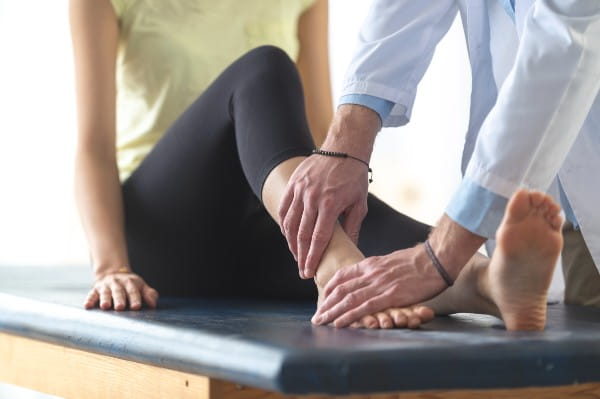Are your feet or ankles stiff, sore or swollen? If walking is becoming uncomfortable or painful, you may be dealing with osteoarthritis—a common condition that occurs when cartilage in your joints wears down over time.
To determine the source of your foot pain and the best treatment, it’s smart to consult a foot and ankle orthopedic surgeon. These specialists can evaluate your symptoms, confirm a diagnosis and recommend personalized options to relieve pain—often starting with non-surgical solutions.
“If your cartilage is worn away, the bones tend to rub against each other, and that friction causes pain. This condition is called osteoarthritis,” explains Jeffrey Levy, D.O., a fellowship-trained foot and ankle orthopedic surgeon with Riverside Orthopedic & Sports Medicine Specialists.
What Is Osteoarthritis in the Foot and Ankle?
Osteoarthritis happens when the cartilage—a tough, flexible tissue that cushions your bones—gradually breaks down. Without that cushioning, your bones rub together, causing pain, stiffness and inflammation.
With more than 26 bones and 30 joints in the foot alone, osteoarthritis can develop in multiple areas, especially:
- The ankle joint
- The midfoot (top of the arch)
- The big toe joint
“The bones and joints inside your foot work together with your muscles, tendons and ligaments to help you bear weight and control your movements,” explains Dr. Levy. “But the breakdown of cartilage in these joints—the osteoarthritis—is painful and limits your ability to walk and perform everyday activities.”
Common Causes of Osteoarthritis in the Feet
Osteoarthritis is often a result of age-related wear and tear, but other factors can also play a role:
Injury
Previous trauma increases the risk of post-traumatic arthritis. Common causes include:
- Foot or ankle fractures
- Severe sprains or ligament tears
- Dislocated or jammed joints
Abnormal Foot Mechanics
Structural issues in the foot can lead to joint strain over time:
- Flat feet can increase pressure on the joints
- High arches may reduce flexibility and shock absorption
Obesity and Excess Weight
“Excess weight puts pressure on your bones and joints too,” says Dr. Levy, “which also leads to deterioration of cartilage.”
Symptoms of Foot and Ankle Osteoarthritis
If you have osteoarthritis in the foot or ankle, you may experience:
- Persistent pain in the foot, ankle or toes
- Stiffness, especially after rest or in the morning
- Swelling and tenderness around the joints
- Redness or warmth in the affected area
- Bone spurs or noticeable bumps
- Limited mobility or difficulty walking
Without treatment, symptoms can worsen over time, potentially leading to joint deformity.
How Osteoarthritis Is Diagnosed
Your foot and ankle specialist will:
- Examine your feet for tenderness, swelling and range of motion
- Ask about your medical history and lifestyle
- Order X-rays to evaluate joint space and bone changes
- Recommend MRI or CT scans for a closer look at soft tissues if needed
Non-Surgical Treatment for Foot and Ankle Osteoarthritis
Many patients find relief from osteoarthritis foot pain with conservative treatment options designed to reduce pain and slow joint degeneration.
First-line treatments may include:
- Anti-inflammatory medications (NSAIDs like ibuprofen)
- Immobilization with a cast, boot or brace
- Orthotics or custom shoe inserts for added support
- Steroid injections to reduce inflammation
- Physical therapy to strengthen muscles and improve joint function
- Weight management to reduce pressure on your joints
“In some cases, we clean the arthritic joint by removing bone spurs that restrict your movement,” Dr. Levy explains. “But we always start with conservative approaches to reduce pain and preserve mobility.”
Injections for Arthritis Pain Relief
Your orthopedic foot and ankle surgeon may recommend targeted injections to reduce swelling and improve joint function. Options include:
- Corticosteroid injections for fast relief
- Viscosupplementation (in select cases) to lubricate the joint
- Regenerative medicine treatments, such as platelet-rich plasma (PRP), in advanced care settings
When Surgery Becomes an Option
If non-surgical osteoarthritis treatments are no longer effective, your doctor may recommend surgery to reduce pain and improve function.
Surgical options may include:
- Debridement – removing bone spurs and inflamed tissue
- Joint fusion (arthrodesis) – permanently joining bones to stop painful movement
- Joint replacement – inserting an artificial joint, most commonly for the ankle or big toe
“If the patient’s arthritis is advanced, we can fuse the joint, stopping the motion that’s causing the pain,” says Dr. Levy. “When making a treatment recommendation, we consider which part of your foot is involved, your lifestyle, and your goals for the future.”
Recovery time varies, but most patients are able to return to walking and light activities with proper rehab and follow-up care.
Minimally Invasive Joint Fusion: A Modern Approach
For certain types of foot and ankle arthritis, minimally invasive joint fusion techniques offer an effective alternative to traditional open surgery. These procedures are performed through small incisions, using specialized tools and advanced imaging to precisely remove damaged tissue and fuse the joint.
“Minimally invasive fusion surgery can provide the same long-term pain relief as traditional methods, but with significantly less soft tissue disruption, smaller scars and faster recovery,” explains Dr. Levy.
Dr. Jeffrey Levy is fellowship-trained in minimally invasive foot and ankle procedures, including joint fusions. He uses this cutting-edge approach when appropriate to reduce recovery times and improve patient comfort.
Benefits of minimally invasive joint fusion include:
- Shorter surgical time and reduced risk of infection
- Less post-operative pain and swelling
- Smaller incisions and minimal scarring
- Quicker rehabilitation and return to activity
Not all patients are candidates for this method, but for those who are, it can offer a smoother path to recovery while delivering the same reliable pain relief and improved mobility that joint fusion is known for.
Regain Your Mobility with Expert Orthopedic Care
If you’re living with foot or ankle pain caused by osteoarthritis, don’t wait to seek treatment. The earlier you address symptoms, the more options you’ll have to stay active and pain-free.
At Riverside Orthopedic & Sports Medicine Specialists, our team offers comprehensive care—from diagnosis to recovery—so you can get back to the things you enjoy.
Call 757-534-9988 to schedule an appointment with Dr. Jeffrey Levy or request a consultation online today.



